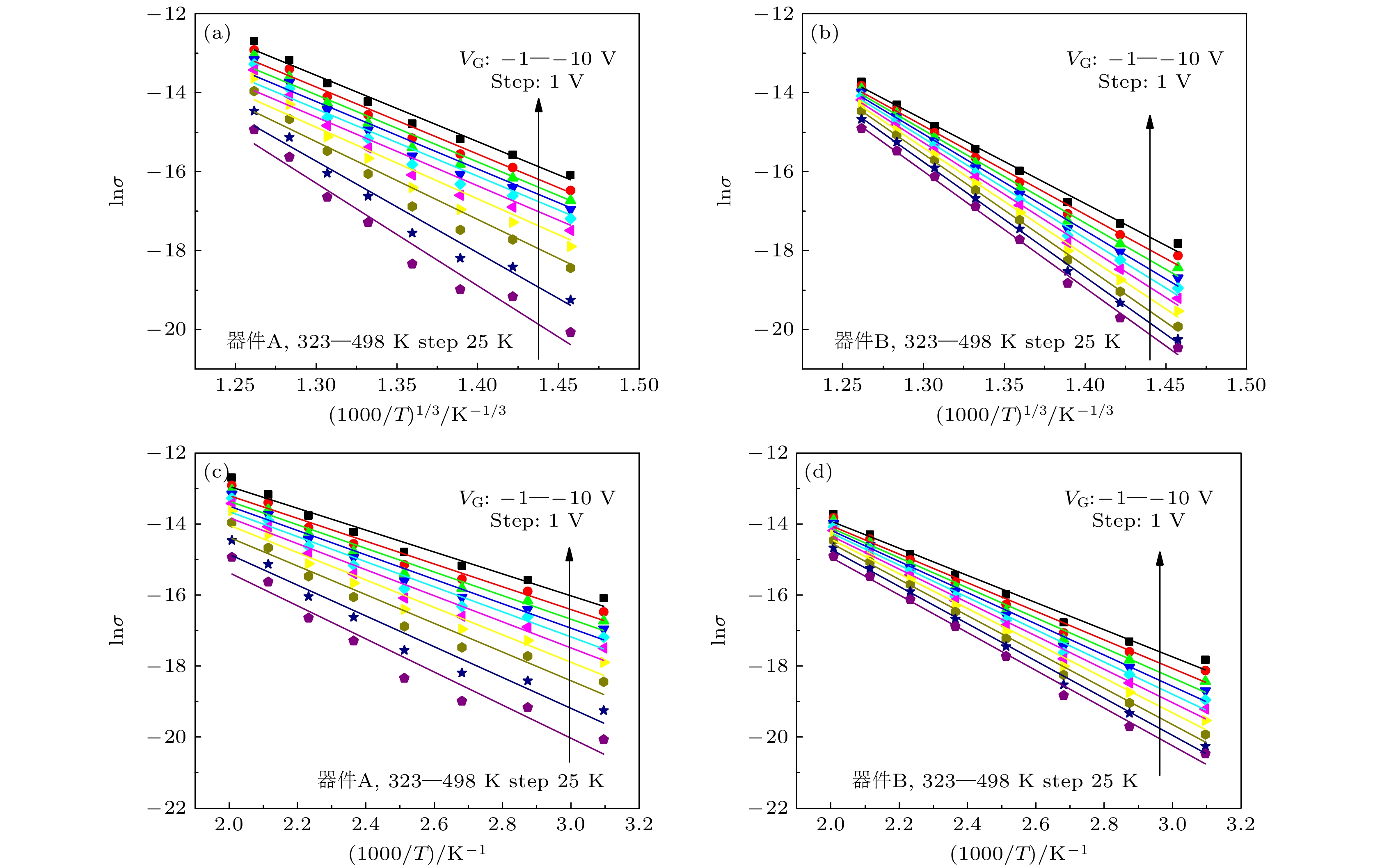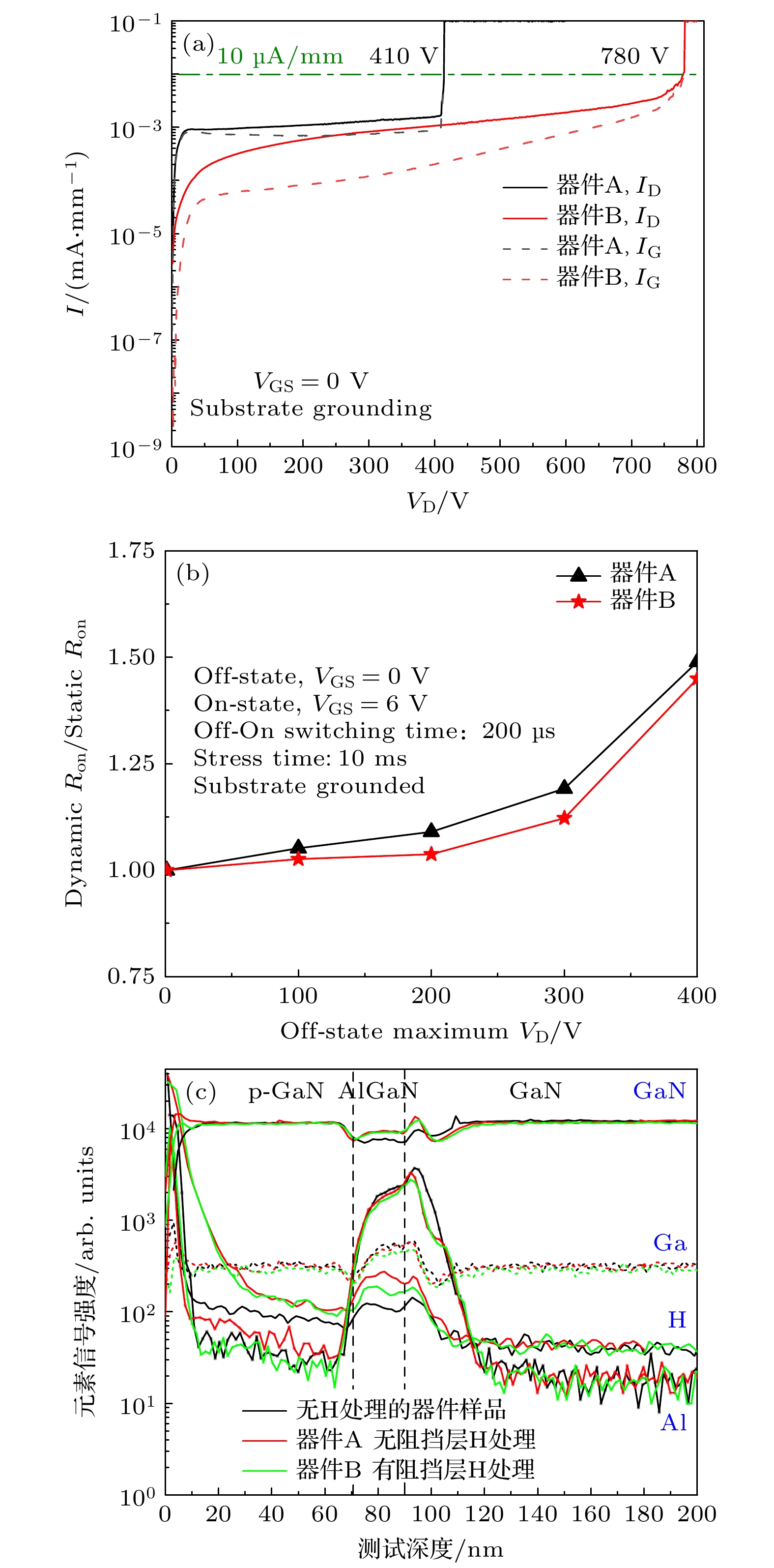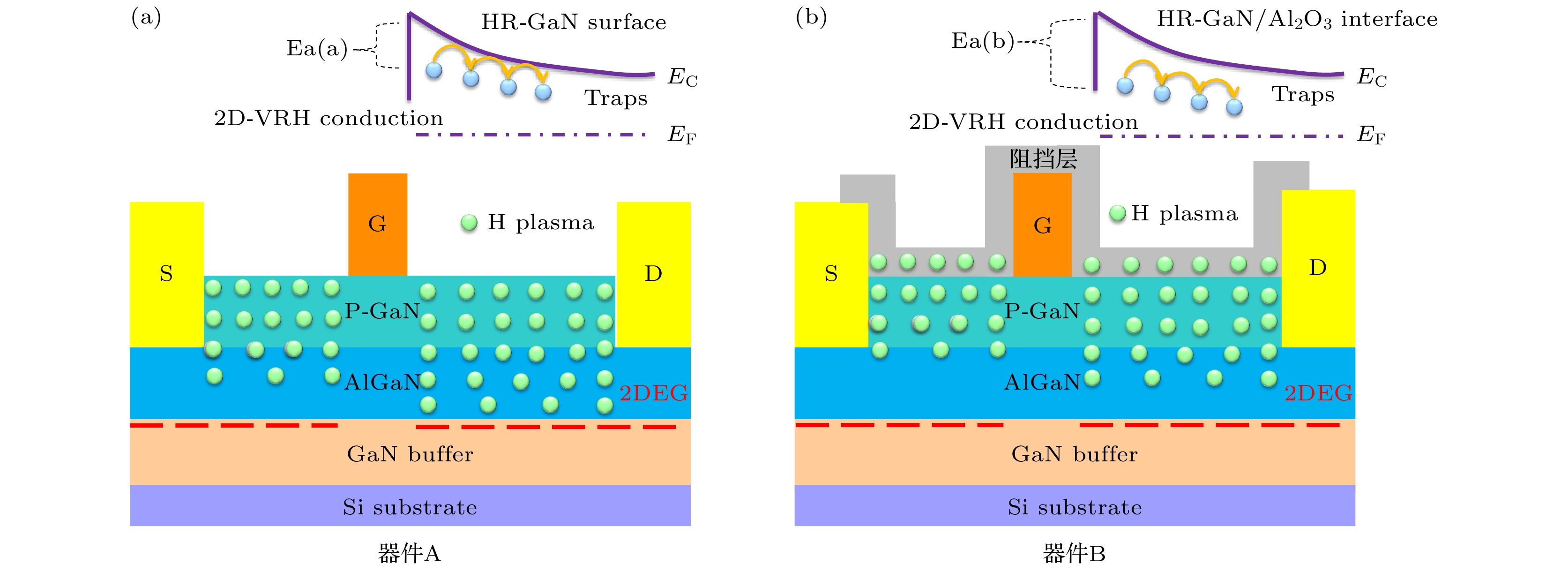-
采用H等离子体处理p-GaN盖帽层来制备p-GaN栅AlGaN/GaN高电子迁移率晶体管(HEMT). 在p-GaN层表面上先沉积2 nm的Al2O3薄膜, 以减少H等离子体注入p-GaN时对表面造成的损伤. 经研究表明沉积Al2O3阻挡层的器件栅极反向泄漏电流降低了一个数量级, 开关比提高了约3倍. 由于栅极泄露电流的减小, 关态击穿电压从410 V提高到780 V. 针对栅极反向泄漏减小的现象, 进行了变温IG-VG测试, 验证了栅极反向泄漏电流的主导机制是二维变程跳跃(Two-dimensional variable range hopping, 2D-VRH)模型. 分析了减小栅极反向电流的原因是由于Al2O3阻挡层改变了HR-GaN的表面态, 使陷阱能级的活化能升高. 此外, 器件动态特性也表现出更稳定的趋势, 这是Al2O3薄膜阻挡过多的H等离子体的注入, 使AlGaN势垒和沟道陷阱态数量减少, 电流崩塌效应减弱.
-
关键词:
- p-GaN栅AlGaN/GaN HEMT /
- H等离子体处理 /
- Al2O3薄膜 /
- 栅极反向泄漏电流
High electron mobility transistors(HEMTs)show tremendous potentials for high mobility, high breakdown voltage, low conduction, low power consumption, and occupy an important piece of the microelectronics field. The high-resistivity-cap-layer high electron mobility transistor (HRCL-HEMT) is a novel device structure. Based on the hole compensation mechanism, the p-GaN is converted into high resistance semiconductor material by hydrogen plasma implantation. Thus, the surface of the p-GaN layer will have a serious bombardment damage under the hydrogen plasma implantation. In practical work, it is also very challenging in the accurate controlling of the hydrogen injection rate, injection depth and injection uniformity. To achieve the required depth of injection, the injected hydrogen plasma is often more than the required dose or multiple injections times. The energy of hydrogen plasma plays a huge influence on the surface of the p-GaN layer.The leakage current will be generated on the device surface, which deteriorates the electrical performance of the device. In this work, to protect the surface of p-GaN layer, a 2-nm Al2O3 film is deposited on the surface of the p-GaN cap layer to reduce the implantation damage caused by hydrogen plasma treatment. The research shows that after the device deposited Al2O3 film prior to the hydrogen plasma treatment, the gate reverse leakage current is reduced by an order of magnitude, the ratio of ION to IOFF is increased by about 3 times. Meanwhile, the OFF-state breakdown voltage is increased from 410 V to 780 V. In addition, when the bias voltage is 400 V, the values of dynamic RON of devices A and B are 1.49 and 1.45 respectively, the device B shows a more stable dynamic performance. To analyze the gate leakage mechanism, a temperature-dependent current IG-VG testing is carried out, and it is found that the dominant mechanism of gate leakage current is two-dimensional variable range hopping (2D-VRH) at reverse gate voltage. The reason for reducing the gate reverse current is analyzed, and the Al2O3 film increases the activation energy of trap level and changes the surface states of HR-GaN; furthermore, the Al2O3 film blocks the injection of too much H plasma, thereby reducing the density of AlGaN barrier and channel trap states, and weakening the current collapse. -
Keywords:
- p-GaN gate AlGaN/GaN HEMT /
- H plasma treatment /
- Al2O3 film /
- gate reverse leakage current
[1] Chen K J, Haberlen O, Lidow A, Tsai C L, Ueda T, Uemoto Y, Wu Y F 2017 IEEE T. Electron. Dev. 64 779
 Google Scholar
Google Scholar
[2] Efthymiou L, Longobardi G, Camuso G, Chien T, Chen M, Udrea F 2017 Appl. Phys. Lett. 110
[3] Ambacher O, Foutz B, Smart J, et al. 2000 J. Appl. Phys. 87 334
 Google Scholar
Google Scholar
[4] Jones E A, Wang F, Costinett D 2016 IEEE J. Em. Sel. Top. P. 4 707
[5] Hu X, Simin G, Yang J, Khan M A, Gaska R, Shur M S 2000 Electron. Lett. 36 753
 Google Scholar
Google Scholar
[6] Uemoto Y, Hikita M, Ueno H, et al. 2007 IEEE T. Electron. Dev. 54 3393
 Google Scholar
Google Scholar
[7] Cai Y, Zhou Y G, Chen K J, Lau K M 2005 IEEE Electr. Device L. 26 435
 Google Scholar
Google Scholar
[8] Tang Z K, Jiang Q M, Lu Y Y, Huang S, Yang S, Tang X, Chen K J 2013 IEEE Electr. Device L. 34 1373
 Google Scholar
Google Scholar
[9] Saito W, Takada Y, Kuraguchi M, Tsuda K, Omura I 2006 IEEE T. Electron. Dev. 53 356
 Google Scholar
Google Scholar
[10] Fujii T, Tsuyukuchi N, Iwaya M, Kamiyama S, Amano H, Akasaki I 2006 Jpn. J. Appl. Phys. 2 45 L1048
 Google Scholar
Google Scholar
[11] Hwang I, Kim J, Choi H S, et al. 2013 IEEE Electr. Device L. 34 202
 Google Scholar
Google Scholar
[12] Tapajna M, Hilt O, Bahat-Treidel E, Wurfl J, Kuzmik J 2016 IEEE Electr. Device L. 37 385
 Google Scholar
Google Scholar
[13] Greco G, Iucolano F, Roccaforte F 2018 Mat. Sci. Semicon. Proc. 78 96
 Google Scholar
Google Scholar
[14] Hao R H, Fu K, Yu G H, et al. 2016 Appl. Phys. Lett. 109
[15] Nakamura S, Iwasa N, Senoh M, Mukai T 1992 Jpn. J. Appl. Phys. 31 1258
 Google Scholar
Google Scholar
[16] Hao R H, Li W Y, Fu K, et al. 2017 IEEE Electr. Device L. 38 1567
 Google Scholar
Google Scholar
[17] Mi M H, Ma X H, Yang L, Bin-Hou, Zhu J J, He Y L, Zhang M, Wu S, Hao Y 2017 Appl. Phys. Lett. 111
[18] Hao R H, Xu N, Yu G H, Song L, Chen F, Zhao J, Deng X G, Li X, Cheng K, Fu K, Cai Y, Zhang X P, Zhang B S 2018 IEEE T. Electron. Dev. 65 1314
 Google Scholar
Google Scholar
[19] Xu N, Hao R H, Chen F, et al. 2018 Appl. Phys. Lett. 113
[20] Chen Y H, Zhang K, Cao M Y, Zhao S L, Zhang J C, Ma X H, Hao Y 2014 Appl. Phys. Lett. 104
[21] Chen X, Zhong Y Z, Zhou Y, et al. 2020 Appl. Phys. Lett. 117
[22] Zhao S L, Hou B, Chen W W, Mi M H, Zheng J X, Zhang J C, Ma X H, Hao Y 2016 IEEE T. Power Electr. 31 1517
[23] Zhang Z L, Yu G H, Zhang X D, et al. 2016 IEEE T. Electron. Dev. 63 731
 Google Scholar
Google Scholar
[24] Binari S C, Ikossi K, Roussos J A, et al. 2001 IEEE T. Electron. Dev. 48 465
 Google Scholar
Google Scholar
[25] Vetury R, Zhang N Q Q, Keller S, Mishra U K 2001 IEEE T. Electron. Dev. 48 560
 Google Scholar
Google Scholar
[26] Jiang H X, Lyu Q F, Zhu R Q, Xiang P, Cheng K, Lau K M 2021 IEEE T. Electron. Dev. 68 653
 Google Scholar
Google Scholar
[27] Zhu M H, Ma J, Nela L, Erine C, Matioli E 2019 IEEE Electr. Device L. 40 1289
 Google Scholar
Google Scholar
[28] Wei X, Zhang X D, Sun C, et al. 2021 IEEE T. Electron. Dev. 68 5041
 Google Scholar
Google Scholar
[29] Yang S, Tang Z K, Wong K Y, Lin Y S, Liu C, Lu Y Y, Huang S, Chen K J 2013 IEEE Electr. Device L 34 1497
 Google Scholar
Google Scholar
-
图 4 (a)从–1— –10 V器件A的
$ \mathrm{l}\mathrm{n}\sigma $ 与$ {(1000/T)}^{1/3} $ 的函数关系; (b)从–1 V— –10 V器件B的$ \mathrm{l}\mathrm{n}\sigma $ 与$ {(1000/T)}^{1/3} $ 的函数关系; (c)从–1— –10 V器件A的$ \mathrm{l}\mathrm{n}\sigma $ 与$ 1000/T $ 的函数关系; (d)从–1— –10 V器件B的$ \mathrm{l}\mathrm{n}\sigma $ 与$ 1000/T $ 的函数关系; 点是实验值, 直线是拟合值Fig. 4. (a)
$ \mathrm{l}\mathrm{n}\sigma $ of device A at VG from –1 V to –10 V as a function of$ {(1/T)}^{1/3} $ ; (b)$ \mathrm{l}\mathrm{n}\sigma $ of device B at VG from –1 V to –10 V as a function of$ {(1/T)}^{1/3} $ ; (c)$ \mathrm{l}\mathrm{n}\sigma $ of device A at VG from –1 V to –10 V as a function of$ 1000/T $ ; (d)$ \mathrm{l}\mathrm{n}\sigma $ of device B at VG from –1 V to –10 V as a function of$ 1000/T $ ; the point is experimental value and the fitted value is a straight line.图 5 (a)器件A和器件B的关态击穿电压对比; (b)器件A和器件B的电流崩塌对比; (c)纵向元素分布SIMS测试结果
Fig. 5. (a) OFF-state breakdown characteristics of device A and device B with substrate grounded; (b) normalized dynamic RON with various values of OFF-state VDS stress from 1 V to 400 V of device A and device B; (c) vertical anatomy of H distribution.
表 1 在不同栅极电压下表面缺陷能级Ea
Table 1. Surface defect level Ea at different gate voltages.
器件Ea/meV 栅极电压/V –10 –9 –8 –7 –6 –5 –4 –3 –2 –1 A 308 321 332 343 353 366 385 404 433 466 B 382 402 422 439 455 470 489 511 524 531 -
[1] Chen K J, Haberlen O, Lidow A, Tsai C L, Ueda T, Uemoto Y, Wu Y F 2017 IEEE T. Electron. Dev. 64 779
 Google Scholar
Google Scholar
[2] Efthymiou L, Longobardi G, Camuso G, Chien T, Chen M, Udrea F 2017 Appl. Phys. Lett. 110
[3] Ambacher O, Foutz B, Smart J, et al. 2000 J. Appl. Phys. 87 334
 Google Scholar
Google Scholar
[4] Jones E A, Wang F, Costinett D 2016 IEEE J. Em. Sel. Top. P. 4 707
[5] Hu X, Simin G, Yang J, Khan M A, Gaska R, Shur M S 2000 Electron. Lett. 36 753
 Google Scholar
Google Scholar
[6] Uemoto Y, Hikita M, Ueno H, et al. 2007 IEEE T. Electron. Dev. 54 3393
 Google Scholar
Google Scholar
[7] Cai Y, Zhou Y G, Chen K J, Lau K M 2005 IEEE Electr. Device L. 26 435
 Google Scholar
Google Scholar
[8] Tang Z K, Jiang Q M, Lu Y Y, Huang S, Yang S, Tang X, Chen K J 2013 IEEE Electr. Device L. 34 1373
 Google Scholar
Google Scholar
[9] Saito W, Takada Y, Kuraguchi M, Tsuda K, Omura I 2006 IEEE T. Electron. Dev. 53 356
 Google Scholar
Google Scholar
[10] Fujii T, Tsuyukuchi N, Iwaya M, Kamiyama S, Amano H, Akasaki I 2006 Jpn. J. Appl. Phys. 2 45 L1048
 Google Scholar
Google Scholar
[11] Hwang I, Kim J, Choi H S, et al. 2013 IEEE Electr. Device L. 34 202
 Google Scholar
Google Scholar
[12] Tapajna M, Hilt O, Bahat-Treidel E, Wurfl J, Kuzmik J 2016 IEEE Electr. Device L. 37 385
 Google Scholar
Google Scholar
[13] Greco G, Iucolano F, Roccaforte F 2018 Mat. Sci. Semicon. Proc. 78 96
 Google Scholar
Google Scholar
[14] Hao R H, Fu K, Yu G H, et al. 2016 Appl. Phys. Lett. 109
[15] Nakamura S, Iwasa N, Senoh M, Mukai T 1992 Jpn. J. Appl. Phys. 31 1258
 Google Scholar
Google Scholar
[16] Hao R H, Li W Y, Fu K, et al. 2017 IEEE Electr. Device L. 38 1567
 Google Scholar
Google Scholar
[17] Mi M H, Ma X H, Yang L, Bin-Hou, Zhu J J, He Y L, Zhang M, Wu S, Hao Y 2017 Appl. Phys. Lett. 111
[18] Hao R H, Xu N, Yu G H, Song L, Chen F, Zhao J, Deng X G, Li X, Cheng K, Fu K, Cai Y, Zhang X P, Zhang B S 2018 IEEE T. Electron. Dev. 65 1314
 Google Scholar
Google Scholar
[19] Xu N, Hao R H, Chen F, et al. 2018 Appl. Phys. Lett. 113
[20] Chen Y H, Zhang K, Cao M Y, Zhao S L, Zhang J C, Ma X H, Hao Y 2014 Appl. Phys. Lett. 104
[21] Chen X, Zhong Y Z, Zhou Y, et al. 2020 Appl. Phys. Lett. 117
[22] Zhao S L, Hou B, Chen W W, Mi M H, Zheng J X, Zhang J C, Ma X H, Hao Y 2016 IEEE T. Power Electr. 31 1517
[23] Zhang Z L, Yu G H, Zhang X D, et al. 2016 IEEE T. Electron. Dev. 63 731
 Google Scholar
Google Scholar
[24] Binari S C, Ikossi K, Roussos J A, et al. 2001 IEEE T. Electron. Dev. 48 465
 Google Scholar
Google Scholar
[25] Vetury R, Zhang N Q Q, Keller S, Mishra U K 2001 IEEE T. Electron. Dev. 48 560
 Google Scholar
Google Scholar
[26] Jiang H X, Lyu Q F, Zhu R Q, Xiang P, Cheng K, Lau K M 2021 IEEE T. Electron. Dev. 68 653
 Google Scholar
Google Scholar
[27] Zhu M H, Ma J, Nela L, Erine C, Matioli E 2019 IEEE Electr. Device L. 40 1289
 Google Scholar
Google Scholar
[28] Wei X, Zhang X D, Sun C, et al. 2021 IEEE T. Electron. Dev. 68 5041
 Google Scholar
Google Scholar
[29] Yang S, Tang Z K, Wong K Y, Lin Y S, Liu C, Lu Y Y, Huang S, Chen K J 2013 IEEE Electr. Device L 34 1497
 Google Scholar
Google Scholar
计量
- 文章访问数: 9899
- PDF下载量: 245
- 被引次数: 0














 下载:
下载:





















